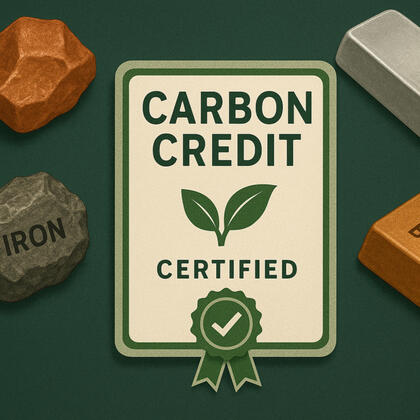
Recycled Materials Sustainability
Credit Brokerage LLC
Matthew Smith
carbon avoidance credits broker
License carrier to an MRV(measure, record, verifier) SaaS
Mission Statement:
Aid other scrap dealers and brokers in turning recycled commodities into an additional added future-ready revenue.Consortium arrangement with 3rd party software as a service contractor
- We act as your broker and service partner:
- Register and manage your credits.
- Package the data into compliance-ready reports.
- Bring the credits to market and secure value for you.
- You focus on your core business. We deliver the extra revenue.
Get Paid more for What You’re Already Doing
Your operation diverts tons of material from waste every day. That activity already reduces carbon emissions — but unless it’s tracked and certified, the value is lost.
We hold the license to a leading carbon credit MRV SaaS platform, making us your gateway to verified avoidance credits.
Why Now?
No Cost, No Risk:
No fees, no setup cost, no added work for your team.
White-Glove Service: We handle the onboarding, tracking, certification, and sales.
New Revenue Stream: You receive quarterly payouts from verified credits — money currently left on the table.
Future-Proof Compliance: ESG reporting in the U.S. is coming fast. Lock in your tracking abilities now, while others will scramble to catch up.
Industry Momentum: Leading companies you know are already positioning — don’t be the last one to move..
Getting out ahead of carbon footprint tracking in the U.S. recycling industry is imperative now, not only as a cost-saving measure but as a strategic necessity. By implementing systems early, operators can avoid the higher expenses of rushed compliance later, while also positioning themselves as leaders in sustainability. Confirmed data already shows that regulatory frameworks are trending toward mandatory reporting, making early adoption a form of risk prevention. Proactive tracking demonstrates readiness for inevitable compliance, builds trust with stakeholders, and creates a competitive advantage in an industry where transparency and accountability are becoming non-negotiable.Ready to Capture Your Share?
Click below to start the conversation. We’ll show you exactly how this works — and why waiting will only cost you.
7 KEY FACTS
1. Carbon Avoidance Credits: Why Scrap Matters
• Every ton of scrap you keep out of the landfill or prevent from being re-mined saves emissions. That’s not marketing spin — that’s physics and chemistry. Recycling avoids the energy-intensive process of mining, refining, and manufacturing new raw materials.
• Example: Recycling 1 ton of steel avoids about 1.6 tons of CO₂ emissions compared to producing new steel.⸻2. “Carbon Avoidance Credits” in Plain Science
• An avoidance credit isn’t a hand-wavy offset. It’s a measurement of how much CO₂ didn’t have to be released because of your actions. In your case, because your scrap replaced virgin material, we can scientifically quantify those avoided emissions.
• These credits are standardized by lifecycle analysis (LCA) methodologies recognized internationally (e.g., ISO 14064, GHG Protocol).⸻3. How the Tracking Works
• If we can track your scrap — what type, what weight, where it’s headed — we can prove its carbon value. That proof gets packaged into digital records. Those records are what the markets recognize as tradable carbon avoidance credits.
• No need to change operations; it’s about capturing data you already have (weights, shipments, buyers).⸻4. Where the Money Comes From
• Corporate America has mandatory reporting pressures and voluntary ESG commitments. Instead of paying a penalty or buying low-quality offsets, they’re willing to pay for verified, U.S.-based, real-world avoidance credits. Your scrap gives them that.
• Exchanges/marketplaces: voluntary carbon markets, private corporate procurement, and sustainability exchanges like XPRIZE Carbon Exchange, Puro.earth, AirCarbon, and Nori.⸻5. How the Exchange Happens
• Think of it like a commodities trade. We generate the verified credit from your scrap, register it digitally, and then sell it on an exchange or directly to a buyer. You get a cut of that sale. The buyer gets the right to claim they’ve avoided X tons of CO₂ through recycled feedstock — and they need that for their sustainability reporting.⸻6. Credibility & Science Anchor
• This isn’t about greenwashing. The math comes from the U.S. EPA, ISO standards, and lifecycle emission factors published by groups like the World Steel Association and Aluminum Association. The numbers stand up in audits.
• For example: EPA’s WARM model (Waste Reduction Model) is already used by municipalities and corporations to calculate avoided emissions from recycling.⸻7. My interests with brokers and dealers:
• Right now, you sell scrap for weight and commodity price only. But every ton of that scrap also has an ability to have a carbon check attached to it. That’s found money. Your buyers — the mills, the foundries, the manufacturers — are already being asked for this data. We can get you paid for being part of the solution instead of others picking up those credits.⸻TAKE AWAYS
• Carbon avoidance is about quantifiable, verifiable science, not guesswork.
• We’re attaching a second revenue stream to what you already do — no change in operations, just better tracking.
• This is where carbon markets are going: real material-based avoidance, not forestry projects halfway across the world.
• You’re sitting on an untapped asset. If we don’t capture it, someone else will — usually your buyer.⸻👉 scrap is no longer “just a scrap commodity” — it’s also a carbon-verified feedstock that unlocks compliance-driven corporate dollars.Give me the go-ahead and I'll show you the $